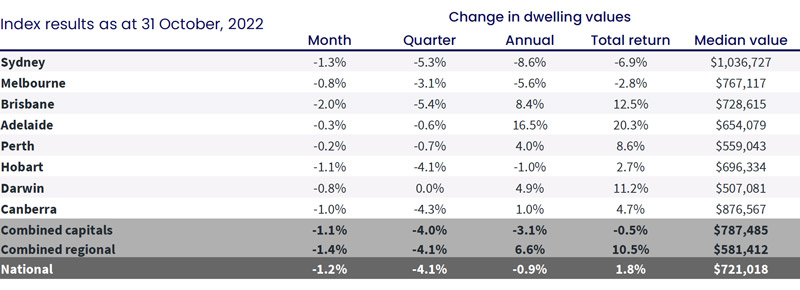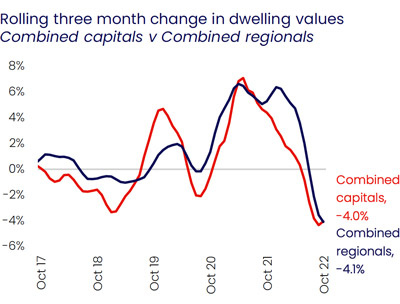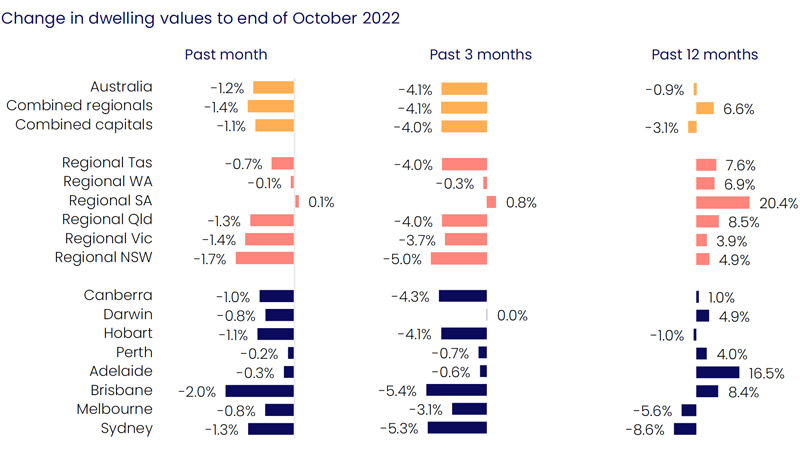Property prices keep tumbling with no end in sight
The scope of Australia’s housing downturn broadened through October, with every capital city and region (except one) recording a drop in housing values last month.
Unless your property is in regional South Australia, the likelihood is that it dropped in price over the last month.
Every other capital city and regional property market dropped in value over the past month, as national dwelling values fell a further 1.2 per cent in October.
Brisbane, not so long ago the shining light of the national real estate market, took the biggest fall among both capital city and regional markets, shedding 2 per cent. Sydney (-1.3 per cent), Hobart (-1.1 per cent) and Canberra (-1.0 per cent) were the next worst performing markets.
Over the course of the past year, Adelaide has been the standout performer, with capital growth of 16.5 per cent, well ahead of Brisbane (8.4 per cent), Darwin (4.9 per cent) and Perth (4.0 per cent).
As interest rates continue to climb, the current run of six consecutive months of national property price declines looks set to continue.

Source: CoreLogic.
CoreLogic’s Research Director, Tim Lawless, said it is probably still too early to claim the worst of the decline phase is over.
“Despite the easing in the pace of decline, with Australian borrowers facing the double whammy of further interest rate hikes along with persistently high and rising inflation, there is a genuine risk we could see the rate of decline re-accelerate as interest rates rise further and household balance sheets become more thinly stretched,” he said.
“To-date, the housing downturn has remained orderly, at least in the context of the significant upswing in values.
“This is supported by a below-average flow of new listings that is keeping overall inventory levels contained and there’s also tight labour market conditions, an accrual of borrower savings and a larger than normal cohort of fixed interest rate borrowers, who have so far been insulated from the rapid rise in interest rates.”
Of 310 sub-regions analysed by CoreLogic, a mere 16 are now at a cyclical price high. As well Adelaide, the more affordable areas of Perth and a handful of regional markets are defying the national trend downwards.
Through the upswing, capital city house values increased by 29.9 per cent, which was more than double the rise in unit values at 13.2 per cent. Since peaking in April, capital city house values have reduced by 7.2 per cent while unit values are down 4.2 per cent.
Exiting the biggest markets
The silver lining to falling home values is a more affordable entry point to the market for buyers.

Source: CoreLogic.
In the most expensive capital city, Sydney, the median house value has fallen by approximately $160,000 since moving through a peak. House values in Melbourne are roughly $76,000 lower and $64,000 lower in Brisbane.
Although borrowing capacity has also reduced sharply, the lower entry point to the market is likely to be a welcome outcome for those looking to buy.
Bobby Haeri, Buyers Agent and Co-Director of The Investors Agency, said his company was no longer purchasing any properties within NSW or Victoria for clients.
“In these states, debt levels are at record highs, rental yields are at record lows and, while migration is starting to ramp up, the majority of those migrating here will be tenants for the first few years, which will put upward pressure on rentals, but not as much pressure on house prices,” Mr Haeri said.
“Instead, investors should be looking into WA, SA and Queensland.
“Markets that have a diverse economy, major government projects, consistent population growth and land scarcity, generally points to a strong economic uplift potential and increase in housing demand, but also the ability to grow in value because they are still considered affordable.”
With inflation hitting a 20-year high last week and interest rates continually rising, household budgets are being stretched to breaking point.
Tim McKibbin, Chief Executive Officer, REINSW, said the higher-than-expected inflation figures will keep forcing the RBA’s hand.
For property prices, this should result in a continuation of the current easing trend, he said.

Source: CoreLogic.
“For transactions, we can expect the status quo, as deals are getting done where expectations are in line with the new market.
“Auctions remain a sound strategy in many markets even though properties may not actually sell under the hammer on the day.
“For consumers, it seems the price of everything is going up - borrowing costs, mortgage repayments, rental prices, energy, petrol and more.
“At some stage, and hopefully soon, the market will need an opportunity to breathe and to be given a chance to absorb the rate hikes to date.”
With advertised stock levels normalising in some regions, along with fewer home sales, prospective buyers have more stock to choose from, less competition from other buyers, an improved negotiation position and more time to make their purchasing decision.
For vendors, homes are taking longer to sell, auction clearance rates are generally below average and vendor discounting rates have become more substantial.
Despite the nationwide property price decline, there are pockets that have enjoyed a stellar year of price growth.
In South Australia, Elizabeth and Salisbury have achieved capital growth of 24.0 per cent over a year. Ipswich (23.0 per cent) and Jimboomba (20.4 per cent) in Brisbane, Melbourne City (10.3 per cent), and Perth’s Rockingham (9.4 per cent) and Kwinana (9.1 per cent) have also enjoyed strong price growth.




















